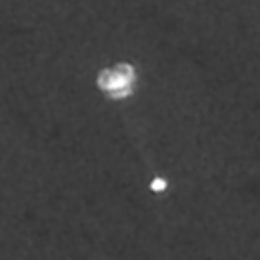 Take a look at the image to the right. Care to guess what you’re looking at?
Take a look at the image to the right. Care to guess what you’re looking at?
I might very well be wrong, but I imagine that more than a few people would guess that they are looking at an image of Curiosity during its descent stage onto the surface of Mars — there’s the chute and there’s the capsule. This would be a reasonable conjecture, but also an incorrect one.
The image is of another rover, Phoenix, making its final descent onto the surface of Mars on May 25, 2008. Remember that one? I didn’t. It was, as it turns out, the first time the landing of one spacecraft on the surface of a planet was photographed by another spacecraft.
Now, I don’t want to make too much of my own forgetfulness or inattentiveness, but I was surprised to learn that Curiosity’s successful landing was the sixth such success in NASA’s history.
Viking 1 and Viking 2 each landed on Mars in 1976. The Mars Pathfinder and its rover, Sojourner landed in 1997. Two rovers, Spirit and Opportunity, landed in 2004. And finally, Phoenix, landed in 2007. (Check out a great info graphic of missions to Mars here. H/T Jeremy Antley.)
I’ve been a low-level space geek since I was child, and so I wasn’t entirely oblivious to this history. But being reminded of it did make the publicity surrounding Curiosity, well, curious.
Why was it that Curiosity’s landing was received with such fanfare? And why was it that it evoked such a powerful emotional response when previous landings, recent and impressive, had not?
Naturally, I took to Twitter with my query. Now, I don’t have nearly enough followers to make this as fruitful a venture as it might be for others, but, thanks to some retweets, it did return a few interesting suggestions.
Here was my initial tweet:
My suggestions were arrived at as follows. Size? Curiosity was by far the largest such vehicle. Degree of difficulty? Given its size, landing the rover safely necessitated an ingenious and elaborate multi-stage landing system. Trailer? I was referring to the dramatically titled video produced by NASA, “Seven Minutes of Terror,” depicting Curiosity’s planned descent. Social media? Well, for starters, Curiosity has its own twitter feed: MarsCuriosity.
So what kind of responses did I get? A few suggested what one person neatly summed up as “Space shuttle ennui.” In other words, Curiosity stepped in to fill a gap created by the retirement of the space shuttles — the last voyage of which tapped the technological sublime.
Relatedly, it was suggested that Curiosity filled a void created by the absence of any inspiring visions for our future in relation to space, or perhaps for any future.
Others pointed to some variation of the suggestions I offered. The complexity of the skycrane, social media coverage of the landing, and NASA’s improved self-promotion.
All of these seem to have some role to play in creating the event that was Curiosity’s landing — the “Seven Minutes of Terror” video hooked me — but I’m not sure that any of these alone, or even all of them together satisfactorily explain the phenomenon.
Here’s my take as it stands: It mostly is a case of the distinctly American technological sublime. This actually draws both streams of responses together: those that focused on the filling up of some collectively felt absence and those that emphasized the sophistication of the technology involved. David Nye’s account of the American technological sublime included both the existential experience of a technology that left one in awe and a participation in what amounted to a (Durkheimian) civil religion.
As a civil religious experience, the technological sublime provided a sense of national identity, purpose, and destiny. Experiences of the technological sublime — whether seeing the first railroads or the first electrified cityscapes, standing before the Hoover Dam, or witnessing a Saturn V launch, to name a few instances — forged the collective national character. They were rituals of solidarity. They inspired confidence in what we could accomplish and, therefore, hope for the future.
It could be argued that we are a nation casting about for renewed unity and sense of purpose. There is a felt need for what the technological sublime had supplied earlier generations of Americans. The consumer technologies which surround us today, impressive as they are in many respects, don’t quite have the capacity to elicit the sublime experience. In part, because they merely (and “merely” is not quite the right word there) enhance or repackage what earlier technologies had first accomplished long ago. The latest cell phone technology can never compete with the experience of hearing a voice over the telephone for the first time, for example.
Curiosity stepped into this fractured and disillusioned cultural milieu and it was dynamic and extraordinary enough to evoke the sublime response. Remember the tears that flowed at mission control. It was the right technology, at the right time. And social media supplied the sense of collective experience so critical to its civil religious function.
So now your thoughts. Did you tune in to the live feed from mission control? Did you give Curiosity more attention than you usually would to the space program? Were you moved by the whole thing? Did you notice that this was the case for others even if wasn’t quite your reaction? Pure media hype? Sheer awesomeness? To what does Curiosity owe its vaunted status?
Maybe its all just Curiosity’s WALL•E-esque anthropomorphic charm. Or, am I the only one that sees that?



